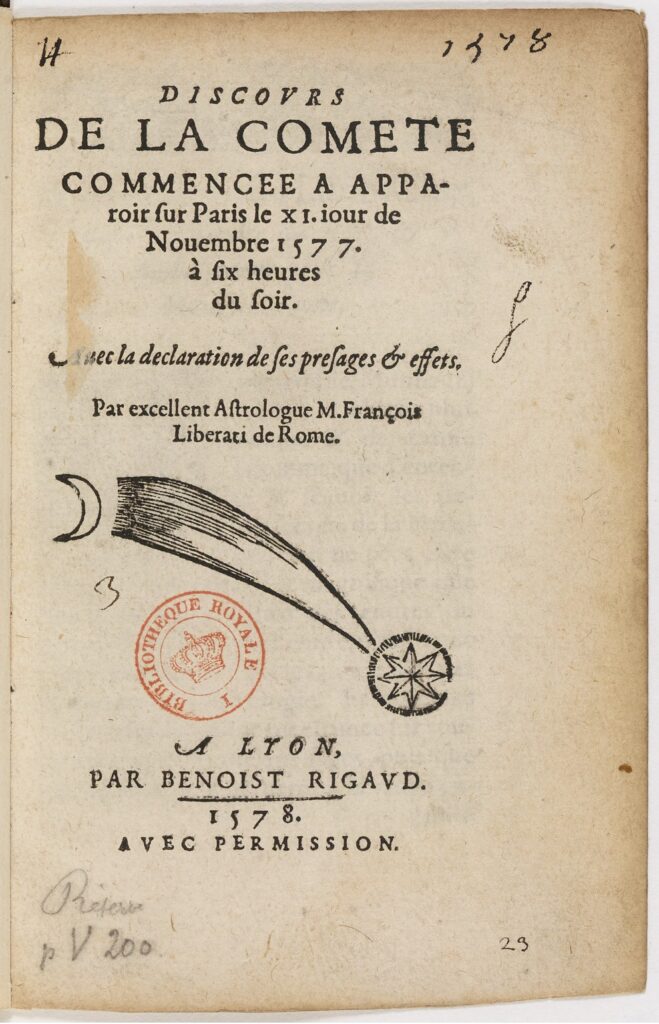Glossary
News pamphlet

Other languages
- Dutch: historieprent
- French: canard, occasionel, canards sanglants, histoire
- German: Newe Zeytungen, illustriertes Flugblatt
- Italian: relazione, verissima/vera relazione, avviso
- Polish: gazeta ulotna, nowina
- Spanish: relación de sucesos
Material form
Printed book, Single-sheet printSubject
News and current affairsDescription
News pamphlets are small printed items containing just a single news fact or event. Across Europe, they were an important means of distributing printed news in the era before periodicals (newspapers).
In the French context these news pamphlets were called canard or occasionel, usually containing sensationalist news (natural disasters, supernatural phenomena, monstrous births etc.) without a political connotation. In France they started to gain popularity from the sixteenth century onwards. They usually had the following structure: starting with a sentence, followed by an exposition of the facts and ending with a moral lesson. Like pamphlets or newsbooks they could comprise multiple pages. They were usually produced in haste. Paper and typography were of a low quality.
In the Dutch context these news pamphlets often took the shape of a printed image of a specific event or figure (e.g. a king), also known as a history print, usually printed on one side of a single sheet, and accompanied by a short explanatory text. The history print could be included with works of chronology or with a short piece of anecdotal history. For example, in a text on the life of a particular figure, the woodcut print would serve as a representation of the subject. Oftentimes these prints were not intended to be historically accurate, and the same woodcut was often repeated for multiple figures, sometimes even within the same text. Similar types of printed images appeared in martyr books, which followed a similar format of showcasing the life of an individual or group in text and image.
History prints were also made of sieges, commonly depicted from a birds-eye view. These prints often included multiple aspects and elements of the larger event, again providing not a wholly historically accurate snapshot of a particular occasion but showing a chronology of events within the same picture. This form of the history print is quite closely related to different forms of news, considering that they were often used to depict not only old, but also more recent historic events that could still have a certain news value.
In the Spanish context, relaciones de sucesos recounted a single news event in prose or verse. Scholars have been debating the genre’s precise definition for many decades now. Their rise in the 16th century was spurred, among others, by the development of the postal network. They flourished especially in the 17th century.
In early modern Italy we encounter a large production of newsletters derived from occasional hand sheets published under titles such as verissima relazione, vera relazione and avviso. In contemporary Italian a news pamphlet is referred to as relazione. In more general terms, but not limited to current events, foglio volante is also used.
Related terms
pamphlet, separates, illustrated broadsheet, iconotext
Sources
S.K. Barker, ‘International News Pamphlets’, in: E. Smith and A. Kesson (eds.), The Elizabethan Top Ten: Defining Print Popularity in Early Modern England (London/New York: Routledge, 2013), 145-155.
P. Burke, ‘Popular History’, in: J. Raymond (ed.), The Oxford History of Popular Print Culture, Vol. 1 (Oxford: Oxford University Press, 2011), 443-454.
CBDRS Catálogo y Biblioteca Digital de Relaciones de Sucesos, https://www.bidiso.es/CBDRS/ediciones/buscador-basico/p/1 (accessed 3 July 2023)
V. Combe, Histoires tragiques et “canards sanglants”: Genre et structure du récit bref épouvantable en France à la fin du XVIe et au début du XVIIe siècle, thesis Université Nice Sophia Antipolis, 2011. https://shs.hal.science/tel-00643307
‘Des canards aux Histoires tragiques, l’information aux XVe-XVIIe siècles’, https://gallica.bnf.fr/html/und/livres/origines-de-la-presse?mode=desktop
C. Espejo Cala, ‘El tiempo de los ciegos: de las relaciones a los romances noticieros’, in: C. Espejo, E. Peñalver, and M.D. Rodríguez, (eds.), Relaciones de Sucesos en la Bibioteca de la Universidad de Sevilla (Sevilla: Universidad de Sevilla, 2008), 50-55.
S. González-Sarasa Hernáez, Tipología editorial del impreso antiguo español, thesis Universidad Complutense de Madrid (2013), 656-674 (‘Relación de sucesos’). https://eprints.ucm.es/id/eprint/24020/
W. Harms (eds.), Das illustrierte Flugblatt in der Kultur der Frühen Neuzeit (Frankfurt am Main: Lang, 1998).
D. Horst, ‘De metafoor as cliché: het beeld van Willem van Oranje in propagandaprenten uit de eerste decennia van de Nederlandse Opstand’, in: J. de Kruif, M. Meijer Drees, J. Salman (eds.), Het lange leven van het pamflet: boekhistorische, iconografische, literaire en politieke aspecten van pamfletten 1600-1900 (Hilversum: Verloren, 2006), 192-201.
C. Klinkert, ‘Knokpartijen, krant en kunst: oorlogsverslaggeving in nieuwsprenten en pamfletten rond 1600’, in: J. de Kruif, M. Meijer Drees, J. Salman (eds.), Het lange leven van het pamflet: boekhistorische, iconografische, literaire en politieke aspecten van pamfletten 1600-1900 (Hilversum: Verloren, 2006), 202-215.
S. Lepape, Gravures de la rue Montorgueil (Paris: BnF Éditions, 2016).
M. Lever, Canards sanglants. Naissance du fait divers (Paris: Fayard, 1993).
B. Vannieuwenhuyze, ‘Reading History Maps: The Siege of Ypres Mapped by Guillaume du Tielt’, Quærendo 45 (2015), 292-321.
J. Nix, ‘Pamfletten tussen historieprenten’, in: J. de Kruif, M. Meijer Drees, J. Salman (eds.), Het lange leven van het pamflet: boekhistorische, iconografische, literaire en politieke aspecten van pamfletten 1600-1900 (Hilversum: Verloren, 2006), 183-191.
J.R. Paas, The German Political Broadsheet, 1600-1700 (Wiesbaden: O. Harrassowitz, 1985).
M. Schilling, Bildpublizistik der frühen Neuzeit: Aufgaben und Leistungen des illustrierten Flugblatts in Deutschland bis um 1700 (Tübingen: Niemeyer, 1990).
J.-P. Séguin, L’information en France avant le périodique. 517 canards imprimés entre 1529 et 1631 (Paris: G.-P. Maisonneuve et Larose/Aubenas: Impr. Lienhart et Cie, 1964).
J.-P. Séguin, ‘“Canards”: une succession ouverte’, in: Th. Delcourt and E. Parinet (eds.), La Bibliothèque bleue & les littératures de colportage (Troyes/Paris, 1999), 185-191.

